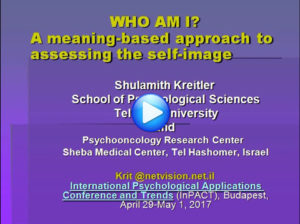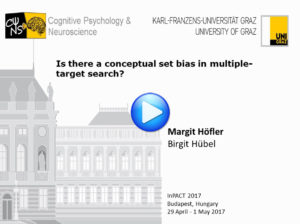Clinical Psychology:
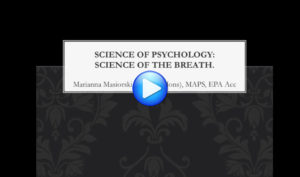 Title: SCIENCE OF PSYCHOLOGY: SCIENCE OF THE BREATH
Title: SCIENCE OF PSYCHOLOGY: SCIENCE OF THE BREATH
Submission code: P_019
Authors: Marianna Masiorski
Abstract: Psychology is originally known to be the study of the breath or Soul. Breathing techniques are common in evidence based psychological and medical practice, however, most techniques seem to be adapted from yoga/spiritual teachings. Studies however appear to focus on the biological/physiological changes that breathing techniques effect rather than the spiritual/Soulful components. One perspective suggests that connection with Soul may also influence physiological markers of health and well-being and suggests that developing connection with Soul may be the primary focus of utilising a specific gentle breath meditation. The gentle breath meditation may deliver different health outcomes to conventional breathing techniques, based on the primary purpose being connection with Soul. Further investigation of the gentle breath meditation is required in order to understand its efficacy as an evidence based psychological and medication treatment protocol.
Keywords: Breathing techniques, breathing and yoga, spirituality.
File Extension: MP4 Video (.mp4)
Title: WHO AM I? A MEANING-BASED APPROACH TO ASSESSING THE SELF-IMAGE
Submission code: VP_031
Authors: Shulamith Kreitler
Abstract: The purpose of the paper is to present a new approach to the assessment of the self image, based on the assumption that the self-image is a concept defined in terms of a set of meanings. In accordance with the Kreitler meaning system, meaning is defined as a pattern of cognitive contents assigned to a referent.
A questionnaire of the self-image has been constructed in which the self functions as the referent and 30 different kinds of contents, corresponding the categories constituting the system of meaning, are presented in the form of items. The subject is requested to respond to the items by checking the degree to which each is important for expressing one’s self. A study is described in which the meaning-based assessment of self (MBAS) was administered to 75 undergraduates, together with questionnaires assessing self identity, self esteem, extent of social relations, and the big five personality traits.
The results showed that scores on MBAS were correlated positively with self esteem, social relations, extroversion, agreeableness and openness, and negatively with diffuse self identity and conscientiousness. The conclusions are that the MBAS is a valid and reliable measure of the self image which unravels the contents constituting the self image.
Keywords: Self-Image, Meaning, Self Identity, Social Relations, Personality Traits.
File Extension: Windows Media Audio/Video file (.wmv)
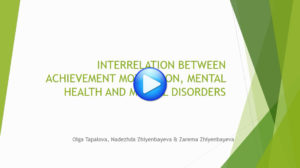 Title: INTERRELATION BETWEEN ACHIEVEMENT MOTIVATION, MENTAL HEALTH AND MENTAL DISORDERS
Title: INTERRELATION BETWEEN ACHIEVEMENT MOTIVATION, MENTAL HEALTH AND MENTAL DISORDERS
Submission code: P_308
Authors: Olga Tapalova, Nadezhda Zhiyenbayeva, & Zarema Zhiyenbayeva
Abstract: The difference in the balance between adaptation and transcendent components of achievement motivation was revealed during the study of the phenomenon of achievement motivation at norm and mental disorders.
Based on conducted empirical study authors obtained results, which became basis for assumption that achievement motivation among people who conventionally called healthy is fundamentally different from the achievement motivation among people with mental pathology. There is a nonlinear relation between mental health, mental disorders and adaptation, transcendent. Mental health requires a balance of two components of the motivational sphere. Sustainable predominance of one of the motivational tendencies with the corresponding stable violation of dynamic equilibrium is a sign of pathology.
The author’s model of achievement motivation explaining key aspect of the studied phenomenon under normal and under pathological mental conditions. The name of the model is based on the idea of the necessity of dynamical equilibrium of two achievement motivation components: adaptive and transcendent.
Keywords: Achievement Motivation, Model, Adaptation, Transcendence, Stress, Human Behavior and Activity, Mental Norm, Mental Disorders.
File Extension: Windows Media Audio/Video file (.wmv)
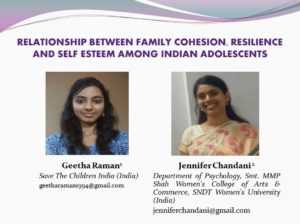 Title: RELATIONSHIP BETWEEN FAMILY COHESION, RESILIENCE AND SELF ESTEEM AMONG INDIAN ADOLESCENTS
Title: RELATIONSHIP BETWEEN FAMILY COHESION, RESILIENCE AND SELF ESTEEM AMONG INDIAN ADOLESCENTS
Submission code: VP_292
Authors: Jennifer Chandani & Geetha Raman
Abstract: A very crucial part of an individual’s life is the adolescence period. This is the period where personalities start getting molded. Hence, focusing on variables related to the development of personalities becomes important. This is also the period when adolescents encounter challenging novel situations or otherwise that may play a major role in determining their adult life success. Attempts have been made earlier to relate and explore cohesion of family i.e. the emotional connection with family members particularly with adolescence age group, especially in the Indian Culture, where there is still higher emphasis given to family. Resilience can be understood as a personality characteristic that moderates the effects of stress and promotes adaptation. Self- esteem, (particularly high self-esteem), is yet another factor that helps and contributes positivity in a person during difficult times, by aiding in the process of recovery. The present study attempted to find out the relationship between Family Cohesion, Resilience and Self-Esteem among Indian adolescents. These variables were measured using The Family Environment Scale (FES), The 14-Item Resilience Scale (RS-14), and Rosenberg’s Self-Esteem Scale respectively. 100 adolescent participants in the age group 12-19 yrs were considered for this study. Convenient Sampling Method was used and all the 3 tests were given to each participant. A Low Positive correlation was found between Family Cohesion and Self-esteem. A Moderate Positive Correlation was found between Family Cohesion and Resilience as well as between Resilience and Self-Esteem. Overall, the obtained results were found to be significant at p<0.01 level.
Keywords: Family Cohesion, Resilience, Self-Esteem, Adolescents.
File Extension: Windows Media Audio/Video file (.wmv)
Educational Psychology:
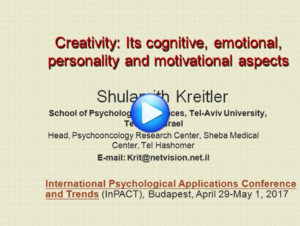 Title: CREATIVITY: ITS COGNITIVE, EMOTIONAL AND MOTIVATIONAL ASPECTS
Title: CREATIVITY: ITS COGNITIVE, EMOTIONAL AND MOTIVATIONAL ASPECTS
Submission code: W_030
Authors: Shulamith Kreitler
Abstract: The paper presents a comprehensive model of the major general and specific factors of creativity in the domains of cognition, motivation, emotions, personality, behavior, and health and its environmental context.
Keywords: Creativity, cognition, motivation, cognitive orientation, meaning.
File Extension: Windows Media Audio/Video file (.wmv)
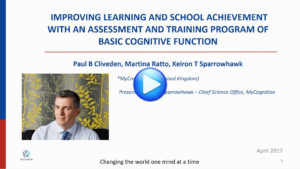 Title: IMPROVING COGNITIVE DEFICITS RELATED TO COMMON PSYCHIATRIC DISORDERS WITH AN INNOVATIVE ASSESSMENT AND TRAINING PROGRAM
Title: IMPROVING COGNITIVE DEFICITS RELATED TO COMMON PSYCHIATRIC DISORDERS WITH AN INNOVATIVE ASSESSMENT AND TRAINING PROGRAM
Submission code: VP_051
Authors: Paul B. Cliveden, Martina Ratto, & Keiron T. Sparrowhawk
Abstract: Cognitive deficits are common in patients with neurodegenerative and psychiatric disorders. The costs associated with administering, analyzing, and reporting for traditional assessments are high and interventional training programs are seldom linked to an assessment’s results. A new program has been developed that integrates an online, self-administered assessment with cognitive training embedded in an engaging video game. The training game dynamically adapts itself to the assessment’s results, providing the user a personalized program focused on improving the weakest domains of cognition. The key domains assessed and trained are attention, working memory, episodic memory, executive function, and processing speed. The assessment uses electronic versions of the most researched, previously validated, psychometric tests to provide a broad evaluation of cognitive function. The assessment has been validated in two cohorts of 19 and 58 patients with psychiatric disorders – obsessive-compulsive disorder, schizophrenia/schizoaffective disorder, or major depressive disorder – who used the new tool alongside the more extensively adopted Cambridge Neuropsychological Automated Test Battery assessments, showing significant correlations between the equivalent subtests. A randomized, controlled trial is in progress to evaluate the effectiveness of the cognitive training program in these patients. The protocol requires playing the videogame for at least 30 minutes per day, three times a week for twelve weeks. Clinical symptoms and cognitive and psychosocial functioning are assessed following the training period. The results of an initial pilot study showed significant improvements in cognitive function, particularly in verbal memory and visual memory. A larger study with an analogous set of patients is in progress.
The positive results achieved justified further studies employing the cognitive program in other psychiatric sets. A preliminary study is in progress as one part of a multimodal intervention program at a clinic for children diagnosed with post-traumatic stress disorder (PTSD) resulting from child sexual abuse. Although it isn’t possible to evaluate the effectiveness of this program’s individual intervention modules, the cognitive assessment’s results have shown large improvements in cognitive function for many in the patient population with commensurate improvements in PTSD symptoms and scores. A study is in progress with a group of hospitalized children affected by a range of psychiatric disorders, investigating both the relationship between the patients’ cognitive function and the psychiatric disorder itself and the potential improvements related to the cognitive training.
Keywords: Cognitive impairments, psychiatric disorders, cognitive assessment and training.
File Extension: Windows Media Audio/Video file (.wmv)
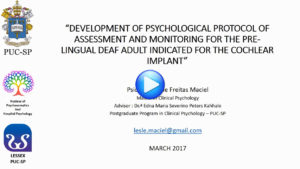 Title: DEVELOPMENT OF PSYCHOLOGICAL PROTOCOL OF EVALUATION AND FOLLOW-UP OF PRE-LINGUAL ADULT DEAF WITH INDICATION FOR THE COCLEAR IMPLANT
Title: DEVELOPMENT OF PSYCHOLOGICAL PROTOCOL OF EVALUATION AND FOLLOW-UP OF PRE-LINGUAL ADULT DEAF WITH INDICATION FOR THE COCLEAR IMPLANT
Submission code: P_131
Authors: Lesle Freitas Maciel & Dra. Edna Maria Severino Peters Kahhale
Abstract: The objective of this research is to develop a protocol of psychological assistance for the profound adult deaf subject who wishes to perform the cochlear implant procedure, hearing aid indicated for deep neurosensorial deafness. The method used was the qualitative analysis of medical records of subjects attended at a Hospital in Curitiba, PR, Brazil, to collect information on care with and without the assistance of psychology. A hearing memory is required for this device to have a suitable hearing response. The pre-lingual deaf, a subject who was born deaf and did not develop this memory needs a specific care to enable the creation of this relationship with the sound world. The Social-Historical Psychology and, in specific Vygotsky’s view on the potential of the subject within the social context, thus allowing the construction of a language of its own allowed an understanding of this person who constituted his subjective world in the absence of sound and in adult life decides to use a device which will put him into the sound world. The hearing health program in Brazil includes formalized protocols in the medical and speech-language area for a group of subjects younger than 3 years and postlingual adults, and there are no guidelines for the psychological area to act with the subject who wishes to make use of the cochlear implant. The creation of this protocol fills a gap in the area, aiming for an integral assistance so that the subject has a broad understanding of his current condition with regard to his little or no experience with sound.
Keywords: Auditory Health, Cochlear Implant, Psychological Evaluation, Deafness.
File Extension: Windows Media Audio/Video file (.wmv)
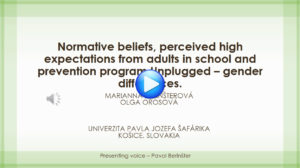 Title: NORMATIVE BELIEFS, PERCEIVED HIGH EXPECTATIONS FROM ADULTS IN SCHOOL AND PREVENTION PROGRAM UNPLUGGED – GENDER DIFFERENCES
Title: NORMATIVE BELIEFS, PERCEIVED HIGH EXPECTATIONS FROM ADULTS IN SCHOOL AND PREVENTION PROGRAM UNPLUGGED – GENDER DIFFERENCES
Submission code: VP_153
Authors: Marianna Berinšterová & Olga Orosová
Abstract: The aim of this contribution was to explore the effectiveness of the universal prevention program Unplugged with respect to behavioral indicator – lifetime prevalence of alcohol use and psychological indicators – descriptive normative beliefs about drunkenness of friends and perceived expectations from adults in school, separately among boys and girls. Moreover, the mediational role of the changes in the perceived high expectations from adults in school in the relationship between changes in descriptive normative beliefs about drunkenness of friends and lifetime prevalence alcohol use among adolescents was examined separately for boys and girls, controlling for school attachment.
Method: Sample consisted of 1298 early adolescents (53.3% girls, Mean age=11.72 years, SD=0.67 years), who took part in the evaluation study of the universal prevention program Unplugged. The sample was divided into groups with respect to gender and program participation. Data were collected before the program implementation (T1), 12 months after the program implementation (T2) and 15 months after the program implementation (T3). Single item measure of normative beliefs was used from the questionnaire of international study ESPAD. Perceived high expectations from adults in school and school attachment were measured by the Resilience and youth development module questionnaire.
Paired sample T test and Wilcoxon test were used for exploring differences between gender and program (non)participation. Linear and binary logistic regression and Sobel test was used for mediational analysis.
Results: Lifetime prevalence of alcohol use increased in all groups between T1 and T3. Descriptive normative beliefs significantly increased, and perceived high expectations from adults in school decreased between T1 and T2, except for girls in the experimental group. Moreover, among girls, mediational role of changes in perceived high expectations from adults was found in the relationship between descriptive normative beliefs about drunkenness of friends and lifetime alcohol use (T3) (Z=2.01; t<0.05).
Conclusion: The effect of the program Unplugged was not confirmed with respect to the behavioral indicator. Gender differences were found in effectiveness of the program Unplugged with respect to psychological variables – descriptive normative beliefs about drunkenness of friends and perceived high expectations from adults in school. Despite the increase in descriptive normative beliefs, perceived positive expectations for adults in school has a protective role regarding lifetime prevalence of alcohol use among girls. These findings contribute to the knowledge about gender differences in effectiveness of Unplugged and suggest the importance of support from significant adults in school.
Keywords: Descriptive normative beliefs, high expectations from adults, alcohol use, Unplugged.
File Extension: Windows Media Audio/Video file (.wmv)
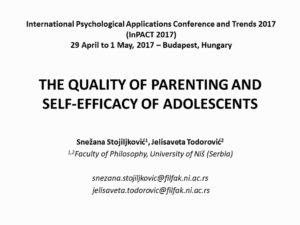 Title: THE QUALITY OF PARENTING AND SELF-EFFICACY OF ADOLESCENTS
Title: THE QUALITY OF PARENTING AND SELF-EFFICACY OF ADOLESCENTS
Submission code: VP_096
Authors: Snežana Stojiljković & Jelisaveta Todorović
Abstract: The family context of growing up is an important factor that can contributes to building a positive self-concept and child’s perception of self-efficacy. According to Bandura’s theory, self-efficacy refers to person’s belief that he can successfully carry out the actions needed to achieve certain goals.
This study was aimed to investigate the relationship between the quality of parenting and self-efficacy of adolescents. The research sample consisted of 148 primary school students from Nis, Serbia, aged 13-14 years. KOBI scale (Vulić-Prtorić, 2002) was used to measure four styles of parenting (acceptance and rejection by mother and father, perceived by their children) and also to estimate the overall satisfaction with family interaction. The questionnaire SEQ-C (Muris, 2001) was used to measure three forms of self-efficacy: a) social – the belief that person is able to relate with peers in an assertive manner, b) academic – the person’s belief about competence to learn and meet the expectations of the school, c) emotional – the belief that the person is able to cope adequately with negative emotions.
The results showed that adolescents perceived their parents as moderately accepting while parental rejection was estimated quite low. Rather high score was obtained on general satisfaction with family (M = 41.25, range 11-55). All this suggests that adolescents perceive their parents primarily as accepting and warm. They also reported high quality of child-parent interaction and satisfaction with the family (M=41.25, range 11-55), which was correlated to emotional self-efficacy (r=.224, p<.01) and academic self-efficacy (r=.209, p<.01). Perceived upbringing style of father was the most important correlate of social self-efficacy of adolescents, which is shown by a positive correlation with father’s acceptance (r=.267, p<.01) and negative correlation with father’s rejection (r=-.207, p<.05); in addition, a negative correlation was found with rejection by the mother (r=-.178, p<.05). Perceived acceptance by parents is the most important correlate of academic self-efficacy of adolescents, which is evidenced by a positive correlation with the acceptance by mother (r=.223, p<.01) and father (r=.192, p<.05); it was also found a negative correlation with father’s rejection (r=-.171, p<.05). A similar picture of the correlates of emotional self-efficacy of adolescents was found: the perceived acceptance of both parents can contribute to their emotional self-efficacy while rejection by the mother may slow it down. These findings are discussed in the light of formative role of parents and the importance of family factors in the development of personality.
Keywords: Parental styles, family satisfaction, self-efficacy, adolescents.
File Extension: Windows Media Audio/Video file (.wmv)
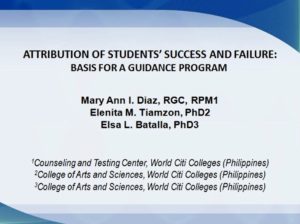 Title: ATTRIBUTION OF STUDENTS’SUCCESS AND FAILURE: BASIS FOR A GUIDANCE PROGRAM
Title: ATTRIBUTION OF STUDENTS’SUCCESS AND FAILURE: BASIS FOR A GUIDANCE PROGRAM
Submission code: OP_058
Authors: Mary Ann I. Diaz, Elenita M. Tiamzon, & Elsa L. Batalla
Abstract: Fritz Heider and Bernard Weiner theory of attribution is a theoretical framework of academic attribution of students’ success and failure. The focus of our research is the identification of the association and attribution of the students’ success and failure.
In this study we presented results carried out by 240 sophomore students of World Citi Colleges, of different programs (180 females and 60 males) by using purposive sampling method. The students with academic performance ranging from 75 to 80 in their high school were considered.
We were interested to find out the difference or the change of success and failure of the sophomore students based on the three major consideration of attribution. As the main source of data, self-constructed questionnaire was used as assessment tool. The assessment tools focused on the academics, career, and personal attribution of students.
The questionnaire was administered in three consecutive days and retrieved back the questionnaires/checklist forms on the same day of the administration.
The study used the weighted mean, ANOVA, t- test and linear regression in the treatment of data to arrive at the results and findings of the study.
The study revealed that on the academics, the success of the students was attributed on study habits and the teachers. The teachers play a big role in the success of the students. However, the results considered the study habits of the students as the primary consideration of their success in terms of their academics.
On the other hand, the failure of the students can be attributed to the teachers’ difficulty in the delivery of the subject matter.
On the Career aspect, the success and failure of the students were attributed with their interest on the chosen program and abilities to perform different activities in the chosen field of specialization.
On the Personal aspect, the success and failure of the students were attributed to their family and environment. The support and cooperation of the family together with the accessibility of the place to school were the major consideration of the students.
Based on the findings, there exists an association between the attributes of success and failure of the students in their academics and this serves as a basis for a guidance program.
Keywords: Attribution, academic, career, personal, and success-failure.
File Extension: Windows Media Audio/Video file (.wmv)
Social Psychology:
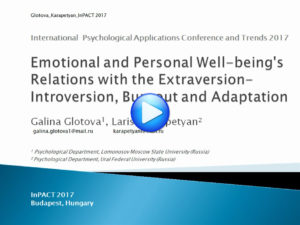 Title: EMOTIONAL AND PERSONAL WELL-BEING’S RELATIONS WITH THE EXTRAVERSION-INTROVERSION, BURNOUT AND ADAPTATION
Title: EMOTIONAL AND PERSONAL WELL-BEING’S RELATIONS WITH THE EXTRAVERSION-INTROVERSION, BURNOUT AND ADAPTATION
Submission code: VP_044
Authors: Galina Glotova & Larisa Karapetyan
Abstract: Objectives: the first objective of the research was to explore how adults assess their emotional and personal well-being. The second objective was to explore psychological correlates of self-assessment of emotional and personal well-being. Design: a quasi-experimental study was conducted.
The correlation analysis (by Spearman) was applied to the data obtained. Methods: the “Self-Assessment of Emotional and Personal Well-being” research technique (Glotova & Karapetyan, 2009) were offered to adults aged 18-65. The participants had to assess themselves on a seven-point scale, using the following parameters: “happy”, “lucky”, “optimist” (positive emotional component А); “successful”, “competent”, “reliable” (positive personal component B); “pessimistic”, “unhappy”, “envious” (negative component C) (Study 1). The results for each of the nine parameters were analysed and the general index of self-assessment of emotional and personal well-being was calculated using this formula: А+B-C. The following research techniques were also used: the Myers Briggs Type Indicator (MBTI, F; EI scale) (Study 2); the Maslach Burnout Inventory (MBI) (Study 3); the Rogers-Diamond Test of Social-Psychological Adaptation (SPA) (Study 4). The results: in Study 1 (n=2229) descriptive statistics were obtained for each of the nine parameters and for the general index of self-assessment of emotional and personal well-being. The results of Study 2 (n=857) showed correlations between extraversion (EI scale MBTI, F) and the positive parameters and the general index of self-assessment of emotional and personal well-being, and correlations between introversion and the negative parameters. The results of Study 3 (n=381) showed the positive parameters and the general index of self-assessment of emotional and personal well-being correlate negatively with the indicators of burnout (MBI), while the negative parameters correlated positively. The results of Study 4 (n=1201) showed the positive parameters and the general index of self-assessment of emotional and personal well-being as positively correlated with the six integral indicators of the SPA research technique, while the negative parameters of emotional and personal well-being correlated negatively with the six integral indicators of the SPA. Conclusion: the results of the obtained data indicate a possibility of using the construct ”emotional and personal well-being” along with the constructs ”subjective well-being” and ”psychological well-being”.
Keywords: Well-being, extraversion-introversion, burnout, adaptation.
File Extension: QuickTime Movie (.mov)
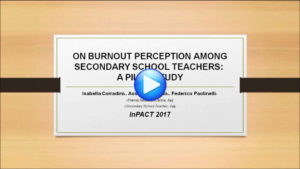 Title: ON BURNOUT PERCEPTION AMONG SECONDARY SCHOOL TEACHERS: A PILOT STUDY
Title: ON BURNOUT PERCEPTION AMONG SECONDARY SCHOOL TEACHERS: A PILOT STUDY
Submission code: VP_133
Authors: Isabella Corradini, Assunta Marano, & Federico Paolinelli
Abstract: Burnout is a stress phenomenon widely described in literature (e.g. Freudenberger, 1974; Maslach 1976; Maslach, Schaufeli and Leiter, 2001, 2009; Cherniss, 1980). It concerns particularly helping professions, as medical and social work professions, but it is increasingly found in any workplace, due to the higher and higher rate of organizational and procedural changes. The focus of our pilot study is the evaluation of teacher’s burnout perception based on the analysis of the following categories defining the professional realization: personal expectations, satisfaction elements, discrepancy elements, perception and management of work difficulties. The study has involved 74 Italian secondary school teachers aged between 25 and 64 (F:24,3%; M:75,7%) from central regions of Italy. The sample completed a subjective multiple response questionnaire on burnout perception (Corradini, Paolinelli, 2016). The sample was stratified with respect to the following variables: age (Percentage/Range 25-34: 6.8%; 35-44: 28.4%; 45-54: 29.7%; 55-64: 35.1%); teaching seniority (Percentage/Range 1-10: 35,1%; 11-21: 25,7%; 21-30: 17.6%; more than 30: 21.6%), gender, and balanced in term of employment status and level of education.
Analyses were conducted using quantitative statistical method to identify satisfaction factors among teachers and their possible correlations and dissimilarities. The correlation analysis with a Spearman method revealed two significant coefficients (salary satisfaction and role recognizing satisfaction) sharing important prediction within each of the two relevant independent variables (salary satisfaction by teaching seniority, R2=.08; role recognizing satisfaction by gender, R2=.10) identified by a stepwise regression.
Even if coming out from a pilot study, these results point to the necessity of adapting prevention measures to the specific characteristics of the considered teachers’ groups. We plan also to extend the study to a larger sample.
Keywords: Burnout, teacher, perception, prevention, workplace.
File Extension: Windows Media Audio/Video file (.wmv)
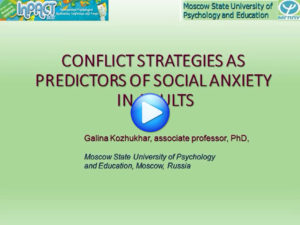 Title: CONFLICT STRATEGIES AS PREDICTORS OF SOCIAL ANXIETY IN ADULTS
Title: CONFLICT STRATEGIES AS PREDICTORS OF SOCIAL ANXIETY IN ADULTS
Submission code: VP_318
Authors: Galina Kozhukhar
Abstract: The issue of social anxiety is becoming increasingly important in modern society, which is caused by a variety of socio-psychological and personal factors. The experience of social anxiety is directly related to the nature of human interaction, that’s why the purpose of work was the study of conflict strategies and manifestation of various types of social anxiety in adults. The main question of study is to identify what kind of conflict strategies are predictors of types of social anxiety and overall level of its intensity in adult respondents. Two methods were used: Social anxiety and social phobia questionnaire (authors Sagalakova, Truevtsev) and Thomas-Kilmann test to determine conflict strategies. The survey involved 106 respondents, all of them with higher education, age from 22 to 46 (M=33.29, SD=5.74), among them 30 men and 76 women. Descriptive statistics, percentage and regression analysis вместо were used for data processing. The main findings allowed to describe the models containing conflict strategies, for each type of social anxiety and general level of its intensity. The average indicator of the level of social phobia was 29.55 points, located on the border between the intermediate zone (social courage – episodic manifestations of social anxiety) and moderately increased social anxiety. At the same time, 46.23% of respondents had an increased social anxiety to a greater or lesser degree. It was found that model that allows to predict the overall level of social anxiety includes 4 conflict strategies out of possible 5, and with a negative sign. This means that if the adults, in a conflict situation, are able to apply competition, compromise, collaboration, and accommodation, their social anxiety reduces. Different strategy models were as predictors for different types of social anxiety. Moreover, avoiding had a direct correlation with an increase of such types of anxiety, as “being in spotlight”, desire to overcome anxiety in expert situations, restraint in expression of emotions, as well as taking the initiative in formal situations because of fear of criticism and possible loss of subjective control. Limitations of study are unbalanced sample by gender and use of only two methods of research. We believe that results of this study will help to carry out the prediction of manifestation of various types of social phobia, based on preferred conflict strategies in adults and to use a change of behavior in conflict with the help of psychological training as a method for preventing and overcoming the various types of social anxiety.
Keywords: Social anxiety, social phobia, conflict strategies, adults.
File Extension: Windows Media Audio/Video file (.wmv)
Cognitive and Experimental Psychology:
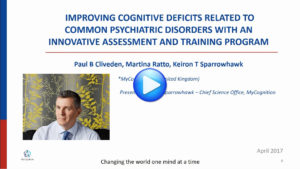 Title: IMPROVING LEARNING AND SCHOOL ACHIEVEMENT WITH AN ASSESSMENT AND TRAINING PROGRAM OF BASIC COGNITIVE FUNCTION
Title: IMPROVING LEARNING AND SCHOOL ACHIEVEMENT WITH AN ASSESSMENT AND TRAINING PROGRAM OF BASIC COGNITIVE FUNCTION
Submission code: VP_050
Authors: Martina Ratto, Paul B Cliveden, & Keiron T Sparrowhawk
Abstract: School achievement has commonly been associated with intelligence and performance scores obtained in skill-assessing tests. However, the identification of the neuropsychological bases of the children’s academic outcomes is often missed by the common intelligence tests, which rely mainly on measures of the skills performed in the test itself, more than on the underlying cognitive functioning. This reflects on the main programs targeting pupils with special educational needs (SEN) and/or learning difficulties or disabilities, since they are focused on improving the academic weaknesses by training these weaknesses. The program presented here, in contrast, is aimed at assessing children’s basic neurocognitive function which underlies a broad range of academic skills and training those domains showing weaknesses.
The program comprises an online, 15-minute, self-administered assessment that includes five extensively validated tests targeted on key cognitive domains – attention, working memory, episodic memory, executive function, and processing speed. The assessment’s results are then used to customise a personalised training program embedded in an engaging and challenging video game, which targets pupils’ weakest domains more intensively. The video game tasks have been designed to be different from the assessment’s tests, ensuring that the scores are immune to a practice effect and that potential improvements are due to an actual improvement in cognitive functioning and not to a single performance skill. A number of case studies have evaluated the potential transfer of cognitive improvements to academic achievement. Initial studies involving more than 600 mainstream school students showed that, for those who completed the recommended training program – video game playing for 90 minutes per week for 12 weeks – significant improvement in cognitive function resulted, especially in working memory and executive function. The relationship of these two cognitive domains with basic academic skills such as reading or mathematics is widely reported in the literature. Further studies involving pupils with SENs or learning difficulties/disabilities showed large improvements across all the cognitive domains with measurable progress in all the main subjects, including mathematics, English, and science for the students who followed the training program, while minor achievements were obtained in a control group participating in a homework class. Current studies are expected to provide additional evidence on the role played by the core cognitive functions in developing mathematics skills.
Keywords: Cognitive assessment and training, learning difficulties, learning disabilities, academic achievement, special educational needs.
File Extension: Windows Media Audio/Video file (.wmv)
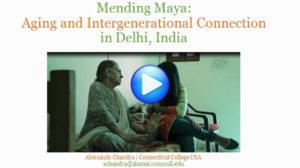 Title: MENDING MAYA: AN ANALYSIS OF AGING AND INTERGENERATIONAL CONNECTION IN DELHI, INDIA
Title: MENDING MAYA: AN ANALYSIS OF AGING AND INTERGENERATIONAL CONNECTION IN DELHI, INDIA
Submission code: VP_119
Authors: Aleksandr Chandra
Abstract: Past research suggests that intergenerational programming can have positive effects in bridging generational gaps. In an effort to explore intergenerational programming in one specific, cosmopolitan community in India, this research examined intergenerational connection and understanding and tested the effectiveness of implementing an art-based intergenerational intervention called Mending Maya.
The intervention engaged seven young adults from a young adult’s empowerment and learning center and eight seniors at an old age home. This eight-week intergenerational intervention connected both young adults and seniors through three specific art forms: music, arts and crafts, and theatre/meditation. Before and after the conclusion of this intergenerational intervention, intergenerational connection and understanding were explored in semi-structured interviews with senior program participants and young adults from the surrounding community (pre-program interviews), and with young adult intervention participants (pre and post-program interviews and structured assessments). Interviews were thematically coded. Results revealed that intergenerational arts programming in New Delhi, India can be an effective way to repair and restore webs of attachments between generations both inside and outside the actual parameters of the program. Aspects of the program that appeared essential to supporting these effects were utilization and maximization of existing community resources and a focus on cultural values that emphasize family and community. The final discussion synthesizes perceptions of aging in a changing world and program evaluations in order to paint a picture of aging as it is currently understood in Delhi, India. The discussion also examines the intergenerational intervention’s relevance to and sustainability within the Delhi community, and suggests ways the Delhi community can utilize intergenerational programming to enhance personal and community development through civic engagement.
Keywords: Aging, art, intergenerational contact, community development, India.
File Extension: Windows Media Audio/Video file (.wmv)
Title: IS THERE A CONCEPTUAL SET BIAS IN MULTIPLE-TARGET SEARCH?
Submission code: VP_202
Authors: Margit Höfler & Birgit Hübel
Abstract: Visual search is the search for a target object (e.g. a particular book on the bookshelf) among distractor objects (e.g. all other books on the shelf). Previous research has indicated that, if we search for more than one target simultaneously in a display, the detection rate of subsequent targets in the display can be reduced once the first target is found. Such subsequent search miss errors (SSMEs) have been shown to be very robust but the underlying mechanisms are still unclear. In the current experiment we tested whether a conceptual set bias might cause SSMEs. Due to a conceptual set bias, a target from a category different to the first target’s category should be missed more often because search is assumed to be guided to those items that share the same category as the first target. For instance, if we search in a display for a drawing of a dangerous weapon among everyday objects and the first weapon we find is a gun, we might miss another category of weapon (e.g. a knife) more often than a weapon of the same category (another gun). In order to test this prediction, we had 26 participants search for drawings of dangerous objects of the same or different categories (guns and/or thrust weapons) within a display of everyday objects. Each search display consisted of 20 items and contained either no, one or two targets. If two targets were in the display, they were either of the same category (e.g. both were guns or both were thrust weapons) or of a different category (one gun and one thrust weapon, respectively). We analysed response times and search accuracy as measures for search performance and possible SSMEs. The results showed that, as expected, the search was overall longer, if only one search target was present as compared to when two or no targets were present. However, search accuracy did not differ with regard to the target category (same or different) and we did not observe a SSME. Together, these results suggest that, at least with the current set of stimuli, there is no conceptual set bias in multiple-target search.
Keywords: Visual search, multiple-target search, subsequent search miss error, attention.
File Extension: Windows Media Audio/Video file (.wmv)

